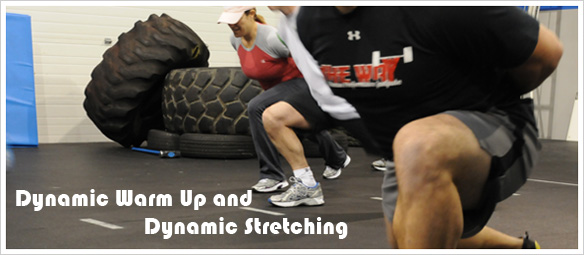A dynamic warm up is essential. Especially for all athletes that want to improve their performance. A good dynamic warm up can improve a variety of psychological and physiological aspects. To begin with, it can prepare the athlete psychologically and physiologically for training or competition.
Furthermore, it can be a transitional phase. This allows the body to adjust to the physiologic, biomechanical, and bioenergetics demands placed on it. As a matter of fact, this is true no matter what exercise phase you’re in. These phases include the training, conditioning, or sports phase. (3)
In addition, a dynamic warm up can be used to gain many training benefits. These include improved strength, and flexibility. Also, improved muscular endurance, and coordination. As well, it includes the correction of major and minor muscle imbalances. (2) Finally, it can also be a time to focus on improving strength, power, speed and agility. (2)
The Two Goals Of A Dynamic Warm Up
There are two primary goals for performing a dynamic warm. First, they are to help improve performance. Second, they help reduce the likelihood of injury. Actually, a dynamic warm up is a good way to improve strength, flexibility, balance and coordination. This is especially true in young athletes.
A dynamic warm up provides a combination of strength and flexibility. This is compared to ordinary static stretching done before training or competition. In contrast, static stretching just lengthens the muscle. On the other hand, dynamic movements cause muscles to lengthen and contract. This causes the muscles, joints, tendons, and ligaments to provide force. Also, this creates a greater functional ability. It alkso creates an extended ROM. Additionally, static stretching requires no voluntary muscle activity. On the other hand, dynamic stretching does require voluntary muscle activity. (2)
Movements should be quality over quantity. They should focus on form. As well, they should focus on full range of motion, posture, and biomechanics. In addition, movement patterns should simulate the training or competition. They should simulate an athlete’s chosen sport.
Furthermore, a dynamic warm up should gradually increase the intensity and volume. In fact, it should be specific to each individual. As well, it should be specific to their sport, position, training or competition. Also, a dynamic warm up should combine cardiovascular and muscular activity. This is designed to increase body temperature. As well, this will reduce DOMS. Finally, a dynamic warm up should be done before practice, workouts, or competition.
A list of benefits of a dynamic warm up is shown below.
Purpose/Benefits Of A Proper Dynamic Warm Up:
- Practice of Motion. This includes Sport Specific Running Biomechanics.
- Increased Muscle Temperature
- Greater Body Core Temperature
- Improved blood flow to active muscles (1)
- Increased metabolic reactions. This leads to greater fuel utilization (1)
- Improvement in muscle elasticity. This reduces the risk of strains and muscle pulls
- Reduction in muscle stiffness
- Reduction in likelihood of injuries (short and long term)
- Improvement in flexibility
- Range of motion of muscles, joints, tendons, and ligaments
- Improvement in speed of muscle contraction in agonist and relaxation of antagonist
- Muscles contract more forcefully and relax more rapidly
- Improvement in the rate of force development and reaction time (1)
- Increased muscle strength and power (1)
- Improvement in dissociation of oxygen from hemoglobin and myoglobin via increase in temperature
- Enhances the release of oxygen to working muscles. This enhances endurance and performance.
- Improvement in speed of nerve impulses and sensitivity of nerves
- Better recruitment of motor units Type I, Type IIa, Type IIb, Type IIx
- Improvement in Psychological/ Mental Preparation
- Mentally prepares athletes for training or competition. It does this by enhancing mood, increasing focus and concentration. Additionally, athletes can also review technique and strategy for training or competition.
- Reduction in muscle viscosity. This leads to a greater economy of movement and ROM
- Decreased Delayed Onset Muscle Soreness (DOMS)
- Less muscle stiffness
Why Should You Not Do Pre Exercise Static Stretching:
In fact, this type of stretching can decrease performance in:
- Strength
- Speed
- Power
Accordingly, this type of stretching is not a good choice. In contrast, you will increase performance potential with dynamic warm ups.
A Sample Dynamic Warm-Up For Football Players:
- 2 minute jog
- Forward Lunge w/Arm Action x 2 10 yards
- Backward Lunge x 2 10 yards
- Side Lunge x 2 10 yards
- 45O Lunge x 2 10 yards
- High Knee x 2 10 yards
- Butt Kick x 2 10 yards
- High Knee Pull x 2 20 yards
- A Skip x 2 20 yards
- B Skip x 2 20 yards
- Shuffle x 2 20 yards
- Carioca x 2 20 yards
- 50 % sprint x 2 40 yards
- Hip Flex/ Ham Combo Lunge x 2 10 yards
- Long Stride Back Pedal x 2 40 yards
With this in mind, then, here’s what a dynamic warm up should consist of:
- To start with, gradually increase the intensity and volume
- Sport specific movements
- 10 to 15 minutes depending on skill level or feeling
- At least 2-5 minutes of cardio. In fact, this is dynamic and works large muscle groups
- Jump Rope, Jogging, Bike, Line Hops
- Quality over quantity
References:
(1) Baechle, R. Thomas. Earle, W. Roger. National Strength and Conditioning Association. Essentials of Strength Training and Conditioning. 3rd Edition. Champaign, Illinois: Human Kinetics; (June 2, 2008)
(2) Kovacs, Mark. Dynamic Stretching: The Revolutionary Warm-Up Method to Improve Power, Performance and Range of Motion. 1st Edition. Berkeley, CA: Ulysses Press, (December 29, 2009)
(3) American College of Sports Medicine. ACSM’s Guidelines for Exercise Testing and Prescription. 8th edition. Baltimore, MD: Lippincott Williams & Wilkins; (February 5, 2009)
Written byJohn Toston



